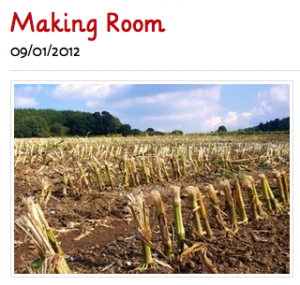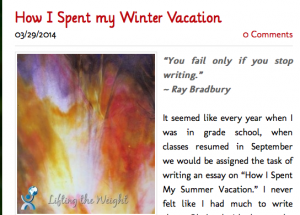(Re)Constructing the Self through Blogging: Lifting the Weight as Recovery Narrative.
Keri Mathis
Introduction: Blogs and the Recovery Narrative
In Lifting the Weight—Living in Balance, the blog’s author Maggie writes in her introduction that she has begun her blog in hopes of “‘lifting the weight’ of depression from [her] soul and moving into a lighter, freer space.” I argue here that perhaps the “freer space” Maggie seeks is provided in the blog medium itself—a space where she can rebuild, reconstruct, and heal from her psychological illness. Many of the rhetorical moves Maggie makes in the blog reflect her desire to use the blog platform in moving toward a “new and improved” self and offer insight into how medium influences narrative, and thus identity (re)construction. What complicates this progression, however, is Maggie’s abrupt and unannounced conclusion in August 2013. Thus, in this discussion, I hope to address the blog’s affordances in aiding narratives like Maggie’s, but also examine the potential pitfalls that could result from its digital, and very public, nature.
Some blogging tools work in positive ways for facilitating recovery and achieving the narrative ends that their authors desire, and these tools are probably what initially attracts most writers in recovery who are like Maggie. For instance, the blog itself can serve as a site of (re)construction upon which the blog’s primary author can reflect on, navigate, assemble, and publish narratives of the self that enable him/her to heal from past afflictions. Writing and publishing these narratives can enable the recovery to occur, but in some cases, these very features ultimately prohibit recovery from happening for reasons that can only be speculated. The blog affordances and limitations I will analyze here include continued narrative and its instability and/or fluidity to show how the blog can enable self-recovery.
Specifically in Lifting the Weight, Maggie seems to have an idea of the narrative end she wants to achieve, and she sees and uses the blog as a space to work toward that goal of a recovered self. Several of the blog’s specific tools and features enable us to see the blog’s ability to foster these goals for recovery, as I will further address in the remainder of this analysis. What I primarily want to emphasize here, then, is that the blog medium demonstrates great potential in helping writers achieve recovery and a (re)constructed self, making it a promising site for composing “recovery narratives”—narratives that allow their writers to cope with illnesses or hardships through writing to recover (and perhaps discover) a healthier self.
On this note, Wendy Brown’s (2008) “Narratives of Mental Health Recovery” highlighted the recovery narrative’s transformative abilities, noting that “[n]arrators describe recovery as a transformative process sometimes ignited by a turning point, but often acknowledged through reflection” (p. 42). The blog medium certainly has the potential to aid the transformative process Brown (2008) emphasized because of its various, unique features. Addressing several of these specific features and examining Maggie’s blog carefully, I hope to demonstrate that recovery narratives can, in fact, be restorative of a person’s well-being and sense of self and that the blog serves as a potentially good platform for these positive changes to occur.
The Blog’s Continued Narrative
One characteristic of the blog that allows the author to rebuild is the potential for a continued progressive narrative. To understand how the blog medium facilitates these narratives in meaningful ways for the writers, it is important to understand some of the essential characteristics of narrative. For the purposes of this paper, the characteristics listed here are most important in trying to understand how the blog and narrative interact productively:
- Narratives provide a means for their authors to make sense of the world around them.
- Narratives are comprised of meaningful events that are carefully chosen by the author. Only certain events (not all events) are included in the narrative.
- Narratives are constructed through invention, or a re-invention of the past.
Considering these essential characteristics of the narrative enables us to see how the blog can accommodate and facilitate the blogger’s narrative, in this case the “recovery narrative,” in ways that allow a transformative process to (continue to) occur.
For instance, the blog offers tools such as the reverse chronological order that gives the author (and his/her readers) a sense of continuation—or a sense that the story is always in the making, always in progress. While the writer and readers write and read in chronological order, the blog’s format highlights the newest, latest information. This focus on the present and future narratives, rather than the past, may facilitate the blog participant’s ability to maintain hope and anticipation that the writer will achieve his or her goal for a healthier, recovered self.
Addressing this notion of continuation and focus on the present, Kathleen Fitzpatrick (2007) argued that “the blog requires a focus on the present tense and a refusal of closure in order to go on” (p. 181). This “refusal of closure,” as Fitzpatrick (2007) suggested, is necessary to the medium because of its focus on the here and now. Reverse chronology reinforces this notion, as the author always has the opportunity to continue by writing another post, which simultaneously gives the reader a sense that the story will continue and the author has more to say. While the author probably has a desired ending in mind—one that includes full recovery—it seems that this open platform for narrative continuation affords the promise of hope that the writer will continue to change and progress, despite any hardships encountered in the present and in the future.
Maggie’s blog demonstrates these particular affordances until its abrupt conclusion in August of 2013. In her most recent post titled “Challenge Yourself,” Maggie begins with a quote by Leigh Steinberg that highlights this very notion of continuation in the rebuilding process: “Challenge yourself; it’s fine not to be a totally finished person.”
In Maggie’s post, she discusses a stained glass project she has been creating and trying to perfect for her new grandchild and makes several connections between the progress she has made on her art project and her journey to overcome depression. She makes this comparison when she writes, “I regained some confidence that I can set goals and achieve them. I reminded myself that it’s okay not to be perfect.” She continues this idea when she questions what she’ll do next: “So what now? On to my next project!” This statement indicates that something else (another blogging identity, perhaps) is forthcoming.
The metaphors Maggie uses to discuss her art and express her continued project of self-growth and recovery reinforce the blog’s narrative affordances. In many instances the blogger feels helpless (as Maggie says she did when she started her blog), and the blog offers a rhetorical space that provides hope for her that her struggles might come to an end, even while her story continues. Maggie thus recognizes that her project of self-recovery will probably never be complete as life continues to throw her into situations that could cause her to relapse. But as evidenced here, she understands that she can consistently make progress toward recovery through writing, publishing, and reflecting on her recovery.
The Blog’s Instability/Fluidity
Similarly, this medium is also inherently unstable, as the narrative continues to build, post after post. On this topic, Fitzpatrick (2007) discussed the example of Dooce, a blog whose author, Heather Armstrong, writes about various life experiences, including bouts of depression. Fitzpatrick (2007) noted that Armstrong, rather than recovering fully, relapses into a depressive state as seen in a couple of her posts. In response to this blog, Fitzpatrick (2007) asked the following question: “Does [Heather’s] admission of the depression’s return invalidate the writing that has gone before? Or does it merely complicate it, revealing the self to be constructed and reconstructed from moment to moment, never stable, but always instead an approximation?” (pp. 179-180).
What Fitzpatrick (2007) suggested here is that perhaps the blog’s narrative is only stable for a brief moment, if it stabilizes at all. Carolyn R. Miller and Dawn Shepherd (2004) also examined the blog’s instability. Miller and Shepherd (2004) ultimately concluded that the blog is not a genre, but rather a medium that undergoes rapid evolutionary change. To support their analysis, the authors quoted genre theorist Catherine F. Schryer who wrote that genres are “stabilized-for-now or stabilized enough sites of social and ideological action” and that “genres come from somewhere and are transforming into something else” (as cited in Miller & Shepherd, 2004, p. 1452).
This notion of the blog being momentarily stabilized is certainly useful when considering the quickly transforming blog and the narrative(s) that inhabit this medium. This instability allows room for change to occur, which is particularly important since the term “recovery” in and of itself implies positive change. The blog’s format and features, then, reinforce this change through its instant publication tools, tagging capabilities, and user feedback options, which are features that supplement the writing platform and enable the writer/reader to reflect on progress that has already been made.
As we see in Lifting the Weight, for example, Maggie constantly references change, and the blog allows her to demonstrate this change in moment-by-moment accounts. In her post titled “A Beginning” (dated July 2012), Maggie provides a brief background of her experiences with clinical depression and then says, “There is a better life out there. A better life in here, within ourselves. And I am on the journey to find that life, to build that life, to lift the weight of depression from my soul as best I can with what I have.” Maggie’s claim that she hopes to “build that [better] life” demonstrates the blog’s useful function as a foundational site on which to likewise build her narrative of recovering the self that she recognizes lies within her; she just needs to rediscover that self through writing on her blog and allow this crucial transformative process to occur.
To document the changes she makes to her lifestyle or habits of thought, Maggie tags her posts with “Change.” In one post listed under this tag titled “Making Room” (dated September 2012), Maggie metaphorically compares her hopes for continuing her journey toward self-discovery and her regrowth to the approaching fall season, noting “But the hopes that are dying now—if the analogy holds—have already reseeded themselves so that come springtime they will grow back even stronger and more plentiful than they were the year before.”
In this post, Maggie’s comparison of her life to the upcoming autumn demonstrates a clear need for change—one that the medium of the blog reinforces and allows Maggie to document and reflect on her own transformation on a moment-by-moment basis.
Furthermore, the blog’s public nature and reader-commenting features contribute to this instability. When creating a blog, the user must understand that she will be writing in a very public domain (unless, of course, she chooses to make the blog private or share with only a select group of readers). On this topic, Miller and Shepherd (2004) wrote that in the blog “[t]here’s both a hope for connection, for community, and at the same time a more traditional voyeuristic enjoyment of stealth and the possibility of a glimpse of unguarded authenticity” (p. 1455). Bloggers, especially those hoping to recover from past traumatic events or psychological illness, often seek out this opportunity for online community, as readers can certainly aid the writer in his/her project of recovery.
Though Maggie appears to have a relatively small readership (based solely on the number of comments that her posts generate), the sense of community is an affordance Maggie uses. In her post “Drawing Lines,” she integrates a comment from a user named Mike and responds to him. Maggie writes:
In truth, I don’t fear failure. I fear being a failure. In response to my previous blog post about fear of failure, a friend of mine, Mike, asked, “Doesn’t ‘success’ or ‘failure’ always relate to a goal of some sort that has been set? The words are meaningless unless something concrete has been chosen to try and accomplish; then the words apply depending upon whether or not one achieves the goal, or how far one misses it by.
Mike’s comment on a previous post clearly caused Maggie to reconsider her understanding of “success” and “failure,” and she responds in this post, saying “Mike is right. Labeling myself as a failure or as a success is meaningless. One is never completely one or the other.”
This example suggests that blog readers can meaningfully contribute to the overall narrative and end goal of recovery and (re)construction of the self. Mike’s question is not simply addressed in a comment by the author; instead, she chooses to reference his question and her reflection on his question in an entirely new post. This communicative act demonstrates the blog’s potential to create community and shows the blog’s constant state of instability, as each user comment contributes to and alters the existing narrative.
While the commenting features can certainly help build community between the writer and reader, it is, however, important to note the possible adverse effects of this commenting tool. For instance, Maggie writes in her introductory note (see “A Beginning“) that she wants to share her journey with readers, stating “I look forward to having your company along the way.” As indicated previously, though, Maggie’s following appears relatively small. The lack of active readership, for instance, could potentially harm her recovery if she feels she needs that sort of participation on her blog. Furthermore, though Maggie’s feedback on the blog is mostly positive, she (and others participating in similar projects) risks receiving negative commentary from her readers. Overall, then, the blog’s instability, as shown here, can both contribute to and limit the user’s progression toward recovery.
Conclusion
As suggested here, the blog’s characteristics offer users the opportunity to continue to grow and rebuild, which is the project of the recovery narrative. Through selecting particular events to detail in the narrative(s) of the blog, the user can begin to make sense of past, present and future events, and the blog can allow this meaning-making that is crucial to the individual’s recovery to take place.
Unfortunately, in the blog examined here, its abrupt conclusion leaves many questions unanswered about the possible affordances and limitations of this medium in providing a platform for composing recovery narratives. On the whole, however, Maggie’s blog and the narrative that exists in the two-year archive she created still showcase the medium’s potentialities in fostering recovery. Her reflection on daily events and her constant reassessment of her progress seemed very promising during this period of active blogging.
Post Script
The initial draft of this paper (completed in December of 2013) notes Maggie’s abrupt conclusion to the blog, as she did not signal to her readers that she would not be continuing her regular blogging practice. On March 29, 2014, however, Maggie resumed blogging with a post titled “How I Spent My Winter Vacation” in which she does not actually write about what she did during her hiatus from writing as her title suggests; instead, she offers useful and insightful commentary on why she blogs and why she suddenly stopped.
Maggie writes, “It’s been seven months since my last blog post. In part, it’s because I’ve been stirring my creative juices elsewhere, designing and building stained glass panels. But on another level, I began to feel that I was exposing too much of myself through blogging.” In this post, Maggie reveals her anxieties about the public nature of the blog, as she seems to recognize that her blog blurs the personal/public binary that characterizes personal blogs. Despite these anxieties, Maggie writes that she has decided to blog again, and she explains her difficulty with understanding this sudden inspiration to write when she recounts her Google search on “why people blog.” After locating an article titled “15 Reasons I Think You Should Blog,” Maggie notes that two particular reasons on the list struck her as significant: one that reads, “You’ll live a more intentional life,” and another which states, “You’ll develop an eye for meaningful things.”
Maggie concludes from these particular points cited in the article that she enjoys writing and wants to continue blogging for the enjoyment it brings her and her readers. She writes, “Writing brings me pleasure, and if it brings pleasure to my readers as well, that’s a huge bonus. So for now, I’m going to open up my little corner of the world again and see what odd bits come to surface in my blogging.” What Maggie’s sudden reappearance on the blog indicates, then, is that the blog medium provides a space for continued narrative. The blogging platform is always there for the writer regardless of whether or not she chooses to write, offering continued hope that can be found in writing to heal and recover.



